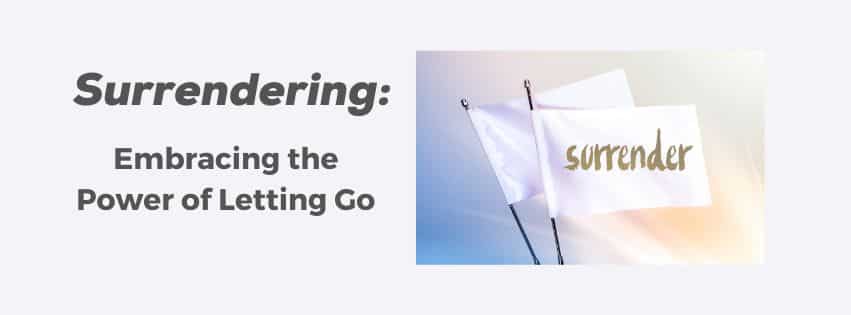
Surrendering: Embracing the Power of Letting Go
Letting go is one of the most challenging yet transformative experiences we can have in life. We often cling to control, fearing the unknown, but true peace comes when we learn to surrender. The power of letting go allows us to release resistance, trust the process, and embrace life as it unfolds.
If you’re seeking deeper personal transformation, learning to let go is an essential step. Transformative Coaching can help you navigate this journey by providing the tools and support you need to release what’s holding you back and step into a more empowered version of yourself.
Understanding the Power of Letting Go
We all encounter moments where holding on feels safer than releasing. But in reality, the power of letting go is what frees us from emotional burdens, fear, and self-imposed limitations. When we surrender, we open ourselves to new possibilities, healing, and a deeper connection with our true selves.
Surrendering doesn’t mean giving up—it means choosing faith over fear, allowing life to flow instead of forcing outcomes.
Why Is Surrender So Challenging?
As humans, we’re wired to seek security and control. We want to protect ourselves from pain and uncertainty, so we cling tightly to things we feel we can influence. Surrendering often means loosening our grip on our deeply held beliefs and releasing old patterns that no longer serve us. Letting go is intimidating because it requires us to step into the unknown, trusting that there is wisdom in the process even if we can’t see it yet.
Signs You Need to Embrace the Power of Letting Go
If you resonate with any of these, it may be time to practice the power of letting go:
- You feel stuck in the past, replaying old memories or regrets.
- Fear of uncertainty keeps you from moving forward.
- You struggle with perfectionism and the need to control everything.
- Holding onto resentment or anger is draining your energy.
- Anxiety about the future is keeping you from enjoying the present.
Acknowledging these signs is the first step toward release. Letting go brings emotional freedom and a sense of inner peace.
6 Steps to Unlock the Power of Letting Go
- Identify What You’re Holding Onto
The first step in surrendering is recognizing what you resist or try to control. Maybe it’s a past hurt, a challenging relationship, or a need to be perfect. Name it, bring it to your awareness, and be honest about how it’s impacting your life. - Acknowledge Your Desire for Control
Accept that the desire for control is natural. Reflect on how attempting to control everything might be limiting you, adding stress, or even causing pain. Understand that letting go doesn’t mean you’re powerless; it means allowing space for greater strength to emerge. - Embrace the Power of Faith
Whether you find faith in God, the universe, or your inner wisdom, trusting in something greater than yourself is essential. In moments of fear or frustration, remind yourself that there is a purpose beyond your immediate understanding. Surrendering is an act of faith—a belief that even in uncertainty, there is guidance. - Practice Letting Go in Small Ways
Surrender doesn’t have to start with life’s most significant issues. Begin with something small, like letting go of the need to control an outcome in a minor situation. Observe the relief it brings and use this as a stepping stone for larger moments of surrender. - Shift from Reaction to Response
Instead of reacting with anxiety or frustration when things don’t go as planned, pause, breathe, and consciously respond. Ask yourself: “How can I see this differently?” or “What is the lesson in this for me?” Surrender involves moving away from a reactive state and into a place of observation and acceptance. - Create a Ritual of Release
Rituals can be powerful in letting go. Write down your worries, fears, or things you can’t control, and then release them—burn the paper, bury it, or throw it away. Physically releasing these items can bring a sense of freedom and lightness.
What Happens When You Surrender
When you choose to surrender (and it is a choice), you allow yourself to move from resistance to acceptance. This shift creates a space for clarity, healing, and new perspectives to emerge. The very act of letting go can feel like lifting a heavy burden, opening the door to peace, joy, and greater resilience.
In my journey, I experienced a moment of surrender that transformed everything. After struggling and resisting the need for help, I reached a point where I could no longer keep up the fight. That moment of surrender was like a gift, an unexpected clarity, and peace that washed over me. I then understood surrender not as a loss but as an invitation to allow grace to guide my steps forward. I was no longer carrying the weight of my burdens alone.
When we surrender, we align with our higher self and invite miracles into our lives. Healing begins not because we have forced it but because we have allowed space for it to unfold naturally. We start seeing signs, receiving insights, and feeling supported in ways we couldn’t have imagined.
Surrendering is not a single act but a practice, a choice we make every day to trust the journey we are on. It’s a profound transformation that teaches us that even in our darkest moments, we are never truly alone.
Final Thoughts: Embrace the Power of Letting Go
If you’re struggling with the idea of surrender, start by simply being open to it. Know that surrendering is not a sign of weakness but of immense strength. It’s the courage to let go and trust that, in doing so, we open ourselves to a life of greater peace, wisdom, and healing.
Surrender may feel like stepping into the unknown, but it is often there, in the depths of our vulnerability, that we find our truest strength. So, breathe, trust, and allow yourself the grace to let go. The path forward might surprise you, bringing growth, peace, and possibilities beyond your imagination.
If you’re ready to experience the power of letting go on a deeper level, Transformative Coaching can help guide you through the process. Let go of what no longer serves you and step into your highest self today.
If you’re holding onto something and want to let it go but can’t, schedule your complimentary Discovery call. Together, we’ll plan the first steps for you to let it go.
🚀 Now is the perfect time to embrace this transformation—because the best version of you is waiting on the other side of letting go.

